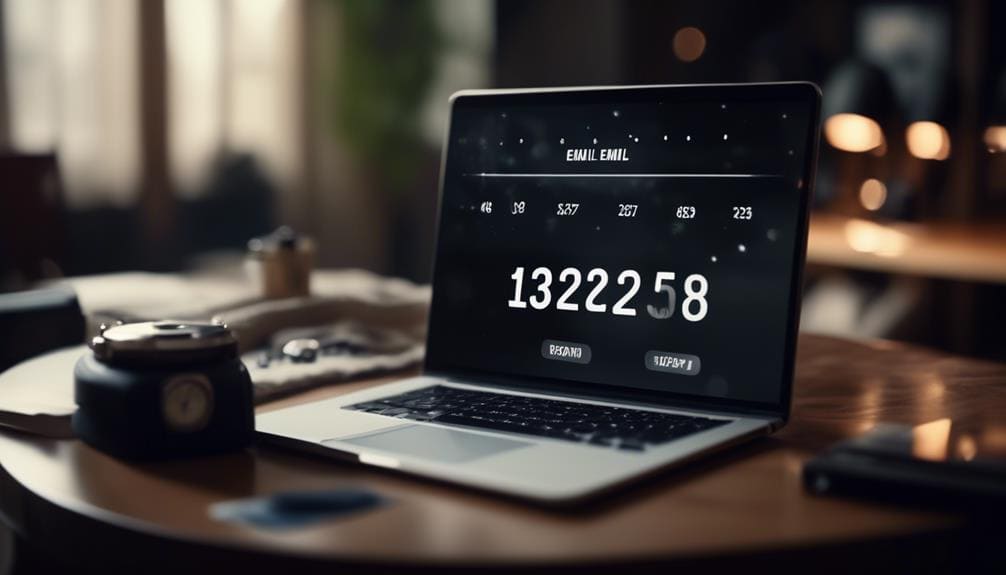Time-Sensitive: The Ultimate Guide to Crafting Personalized Emails That Convert
So, you think you've mastered the art of email marketing? You've sent out countless messages, meticulously crafted to grab your audience's attention and drive conversions. But here's the thing – in today's fast-paced digital world, generic emails just won't cut it anymore.
If you want to truly connect with your subscribers and boost your conversion rates, personalization is the name of the game. And that's where this ultimate guide comes in. With a focus on time-sensitivity and tailored content, it will take your email marketing to the next level.
But I won't spoil all the secrets just yet. Trust me, you'll want to stick around for what's coming next.
Key Takeaways
- Personalization is crucial for building trust and establishing a strong connection with customers.
- Effective email segmentation leads to higher open rates and click-through rates.
- Crafting compelling subject lines increases open rates and engagement.
- Utilizing dynamic content and time-sensitive offers enhances customer experience and boosts conversion rates.
The Importance of Personalization

Crafting personalized emails that convert is essential in today's digital age, where customers expect tailored communication that speaks directly to their needs and desires. Personalization isn't just about addressing customers by their first names; it goes beyond that. It's about understanding their preferences, interests, and pain points. By doing so, you can improve the customer experience and drive customer loyalty.
When you send personalized emails, you show your customers that you value them as individuals. You demonstrate that you understand their unique needs and are committed to meeting them. This level of attention and care builds trust and establishes a strong connection between you and your customers.
Personalized emails also allow you to deliver relevant content that resonates with your customers. By segmenting your audience and tailoring your messages accordingly, you can provide them with information that's meaningful and useful to them. This not only improves their overall experience, but it also increases the likelihood of them taking the desired action, whether it's making a purchase, signing up for a newsletter, or engaging with your brand.
Understanding Your Audience
To craft personalized emails that convert, you need to understand your audience inside out.
Audience analysis techniques help you gather valuable insights about their preferences, needs, and pain points.
Audience Analysis Techniques
Understanding your audience is the key to crafting personalized emails that convert. By conducting audience profiling and demographic analysis, you can gather valuable insights that will help you create email content that resonates with your recipients.
Here are three audience analysis techniques that will take your email marketing to the next level:
- Segmentation: Divide your audience into distinct groups based on shared characteristics such as age, location, or interests. This allows you to tailor your messages to each segment's specific needs and preferences.
- Surveys and feedback: Engage with your audience by asking for their opinions and feedback. This not only helps you understand their preferences but also makes them feel valued and heard.
- Social media listening: Monitor your audience's conversations on social media platforms to gain insights into their interests, challenges, and aspirations. This information can inform your email content and make it more relevant to their lives.
Personalization Strategies
By harnessing the power of audience analysis techniques, you can unlock the potential of personalized email marketing and connect with your recipients on a deeper level. Understanding your audience is crucial to crafting personalized emails that resonate with them. To help you get started, here are some personalization strategies and tools you can utilize:
| Personalization Techniques | Personalization Tools | Benefits |
|---|---|---|
| Segment your audience based on demographics, interests, and behavior. | Email marketing platforms like MailChimp and HubSpot. | Deliver targeted content and offers to specific segments, increasing engagement and conversion rates. |
| Use dynamic content to tailor your emails based on recipient's preferences. | Personalization software such as Dynamic Yield and Evergage. | Show relevant products or content that matches each recipient's interests, leading to higher click-through rates. |
| Personalize subject lines and email copy with recipient's name or location. | Email marketing automation tools like GetResponse and ActiveCampaign. | Grab attention and create a sense of familiarity, increasing open and response rates. |
Effective Email Segmentation
Unlock the power of effective email segmentation by delving deep into the understanding of your audience. Email personalization is key to connecting with your subscribers on a deeper level, and effective targeting is the secret sauce to achieving this.
Here are three reasons why effective email segmentation is crucial for success:
- Higher Open Rates: By segmenting your email list based on demographics, interests, or purchasing behavior, you can send targeted emails that resonate with each segment, leading to higher open rates.
- Increased Click-Through Rates: When you tailor your emails to specific segments, you can provide content that's relevant and valuable to them, resulting in higher click-through rates.
- Improved Conversion Rates: By personalizing your emails and targeting them to the right audience, you can drive more conversions and achieve your desired outcomes.
Understanding your audience and implementing effective email segmentation strategies will help you create personalized emails that convert, ultimately serving your audience better.
Utilizing Data for Effective Segmentation
Crafting personalized emails that convert starts with effectively utilizing data to segment your audience. By implementing data-driven segmentation, you can tailor your messaging to specific groups, increasing the chances of engagement and conversion.
The key is to gather relevant information about your subscribers and use it strategically to create targeted messages that resonate with their needs and interests.
Start by collecting data through sign-up forms, surveys, and past interactions. This valuable information can include demographics, preferences, purchase history, and browsing behavior. Analyze this data to identify patterns and common characteristics among your subscribers. Group them based on their similarities, such as age, location, or previous purchases.
Once you have segmented your audience, you can craft personalized emails that speak directly to their unique needs and desires. Use their names in the subject line or greeting to create a sense of familiarity and connection. Personalize the content by referencing their past purchases or browsing history, offering relevant product recommendations or exclusive discounts.
Crafting Compelling Subject Lines

Are your email subject lines captivating enough to grab your reader's attention?
Crafting compelling subject lines is key to increasing open rates and engagement.
With effective subject line strategies, you can pique curiosity, create a sense of urgency, or offer a solution to your recipient's pain points.
Don't miss out on the opportunity to make a strong first impression and boost your email conversion rates.
Captivating Email Subject Lines
Discover the secret to captivating your audience with irresistible email subject lines. Crafting creative subject lines is crucial for boosting your email open rates and grabbing the attention of your recipients.
To help you stand out in crowded inboxes, here are three powerful techniques to consider:
- Personalization: Tailor your subject lines to address your recipients by name or include specific details relevant to their interests or previous interactions.
- Curiosity: Pique your audience's interest by using intriguing and mysterious subject lines that make them curious to learn more.
- Urgency: Create a sense of urgency by using time-sensitive language or limited-time offers, encouraging your recipients to open your email right away.
Engaging Subject Line Strategies
To truly captivate your audience and compel them to open your emails, mastering the art of crafting compelling subject lines is essential. The subject line is the first thing your audience sees, so it needs to grab their attention and entice them to click. Here are some effective subject line tips to help you create engaging emails:
| Engaging Subject Line Examples | Effective Subject Line Tips |
|---|---|
| "Limited time offer: 50% off!" | Create a sense of urgency |
| "Unlock the secret to success" | Spark curiosity |
| "You're invited: Exclusive event" | Make it personal |
| "Don't miss out on this opportunity" | Highlight a benefit |
Dynamic Content for Personalized Emails
Craft personalized emails that engage your audience with dynamic content. By incorporating dynamic content in your emails, you can create a personalized and tailored experience for each recipient.
Here are three reasons why dynamic content is essential for email personalization:
- Increased Relevance: Dynamic content allows you to customize the email based on the recipient's preferences, behavior, or demographic information. By showing content that's specifically relevant to them, you can grab their attention and increase the chances of conversion.
- Improved Engagement: When you include dynamic elements such as personalized product recommendations, location-based offers, or countdown timers, it creates a sense of urgency and excitement. This not only captures the reader's attention but also encourages them to take action.
- Enhanced Customer Experience: Personalization through dynamic content shows your audience that you value their individual needs and preferences. It makes them feel special and understood, which can lead to stronger customer loyalty and satisfaction.
Implementing Time-Sensitive Offers

Are you looking for a way to boost your email marketing conversion rates?
One effective strategy is implementing time-sensitive offers. By creating a sense of urgency and offering time-limited promotions, you can motivate your subscribers to take immediate action.
Whether it's a limited-time discount, a flash sale, or an exclusive offer, time-sensitive offers can create a sense of FOMO (fear of missing out) and drive higher engagement and conversions.
Urgency in Email Marketing
With a limited time offer, you can create a sense of urgency in your email marketing campaigns, compelling recipients to take immediate action. Implementing urgency tactics in your emails can significantly increase open rates, click-through rates, and conversions.
Here are three effective ways to create a sense of urgency in your email marketing:
- Use time-limited offers: Set a deadline for your offer to create a sense of urgency and encourage immediate action.
- Highlight limited stock or availability: Let your recipients know that your product or service is in high demand and may run out soon.
- Offer exclusive deals or discounts: Provide special discounts or offers that are only available for a limited time, making recipients feel like they're getting a unique opportunity.
Time-Limited Promotions
To further captivate your audience and drive immediate action, consider implementing time-limited promotions in your email marketing campaigns. Limited time offers are a powerful tool to create urgency and encourage your subscribers to take action before it's too late. By offering exclusive deals or discounts that expire within a specific timeframe, you can motivate your audience to make a purchase or take advantage of your offer right away. To help you understand the impact of time-limited promotions, take a look at the table below:
| Offer | Duration | Benefits |
|---|---|---|
| 50% Off | 24 hours | Save money on your purchase |
| Free Shipping | 48 hours | Enjoy fast and free delivery |
| Buy One Get One Free | 72 hours | Get double the value for your money |
| Flash Sale | 4 hours | Grab incredible deals for a limited time |
| Early Bird Discount | 1 week | Secure your spot at a discounted price |
Implementing time-limited promotions in your email marketing campaigns will not only increase your open and click-through rates but also drive conversions and boost revenue. Don't miss out on the opportunity to create a sense of urgency and provide your audience with irresistible offers.
Leveraging Behavioral Triggers
By analyzing your audience's online behavior, you can strategically harness their actions to create personalized emails that drive conversions. Understanding behavioral psychology and identifying trigger events can help you tailor your email content to resonate with your audience on a deeper level.
Here's how you can leverage behavioral triggers to craft highly effective emails:
- Segment your audience based on their browsing behavior: By tracking the pages your subscribers visit on your website, you can gain valuable insights into their interests and preferences. Use this information to group your audience into segments and send them targeted emails that align with their specific needs.
- Send personalized recommendations based on past purchases: Utilize data from previous purchases to recommend products or services that complement your customers' previous buying behavior. By showing that you understand their preferences and can anticipate their needs, you increase the likelihood of conversion.
- Use behavioral triggers to create timely email campaigns: Identify trigger events, such as abandoned carts or website browsing patterns, and send automated emails that address these actions. By reaching out to your audience at the right moment, you can provide the necessary nudge to move them closer to making a purchase.
A/B Testing and Optimization

Optimize your email campaigns and increase conversion rates by conducting A/B testing to determine the most effective strategies for engaging your audience. A/B testing techniques allow you to compare different versions of your emails and identify the elements that resonate the most with your recipients. This valuable data can then be used to refine your email marketing strategy and drive better results.
To start, choose one element of your email to test. It could be the subject line, the call-to-action button, or even the layout. Create two versions of your email, with only one element being different between them. Send these variations to two randomly selected segments of your audience and track the performance metrics.
When analyzing the results, focus on the metrics that matter most to your business, such as open rates, click-through rates, and conversion rates. By comparing these metrics between the two versions, you can determine which variation performed better and understand why.
Once you have identified the winning version, implement the successful element into your future email campaigns. But remember, optimization strategies shouldn't stop there. Continuously test and refine different elements of your emails to uncover even more effective strategies for engaging your audience.
Tracking and Analyzing Email Performance
Enhance your email marketing strategy by gaining insights into the performance of your emails through tracking and analysis. Tracking the effectiveness of your email campaigns is crucial to understand what works and what doesn't. By analyzing email metrics, you can make data-driven decisions to optimize your future campaigns and achieve better results.
Here are three key reasons why tracking and analyzing email performance is essential:
- Measure engagement: Tracking email open rates, click-through rates, and conversion rates allows you to gauge how engaged your audience is with your content. By understanding which emails are resonating with your subscribers, you can tailor your future messages to their preferences and increase engagement.
- Identify areas for improvement: Analyzing email metrics helps you identify areas where your email campaigns may be falling short. Whether it's low open rates, high unsubscribe rates, or low click-through rates, tracking these metrics allows you to pinpoint areas for improvement and make necessary adjustments to boost performance.
- Optimize your strategy: By tracking and analyzing email performance, you can gather valuable insights about your audience's behavior and preferences. This information can help you optimize your email marketing strategy by segmenting your audience, personalizing your content, and sending emails at the right time to maximize engagement and conversions.
Tracking and analyzing email performance isn't just about measuring success; it's about continuously improving and delivering value to your subscribers. By leveraging email metrics, you can refine your strategy and create personalized emails that truly convert.
Automation and Personalization Integration

Integrating automation and personalization is key to crafting effective and engaging emails that convert. By combining the power of automation with the personal touch of tailored content, you can create emails that resonate with your audience and drive them to take action.
Automation offers numerous benefits when it comes to email marketing. It allows you to streamline your email campaigns, saving you time and effort. With automated workflows, you can send targeted emails based on specific triggers or actions taken by your subscribers. This ensures that each email is relevant and timely, increasing the chances of conversion.
However, personalization can present its challenges. It requires collecting and analyzing data to understand your audience and their preferences. You need to segment your subscribers based on various criteria such as demographics, behavior, or purchase history. This can be time-consuming and complex, especially if you have a large subscriber base.
To help you better understand the benefits of automation and the challenges of personalization, let's take a look at the following table:
| Automation Benefits | Personalization Challenges |
|---|---|
| Saves time and effort | Collecting and analyzing data |
| Streamlines email campaigns | Segmenting subscribers |
| Sends targeted and relevant emails | Complex for a large subscriber base |
Integrating automation and personalization allows you to create highly personalized email campaigns at scale. It empowers you to deliver the right message to the right person at the right time, ultimately driving conversions and nurturing customer relationships.
Frequently Asked Questions
How Do I Determine the Best Time to Send Time-Sensitive Offers?
To determine the best time to send time-sensitive offers, consider your target audience's habits and preferences. Experiment with different send times and track the response rates. Create urgency in personalized emails by using compelling language and limited-time offers.
What Are Some Examples of Effective Behavioral Triggers to Include in Personalized Emails?
To craft effective personalized emails, include behavioral triggers tailored to your audience. Segmentation is key, as it allows you to target specific interests and actions. By doing so, you'll increase engagement and conversion rates.
How Do I Track and Analyze the Performance of Personalized Emails?
To track and analyze the performance of your personalized emails, use email marketing metrics. Monitor open rates and click-through rates to gauge effectiveness. Experiment with subject lines, content, and timing strategies to improve open rates and boost conversions.
Can You Provide Some Tips for Integrating Automation and Personalization in Email Campaigns?
You can boost your email campaign by integrating automation and personalization. Use automated segmentation to target specific groups, and create personalized email templates to connect with your audience on a deeper level.
What Are Some Common Mistakes to Avoid When Crafting Subject Lines for Personalized Emails?
When crafting subject lines for personalized emails, it's important to avoid common mistakes. Effective email openers grab attention, so steer clear of generic or misleading subject lines that could turn off your audience.
Conclusion
Congratulations! You're now equipped with the ultimate guide to crafting personalized emails that convert.
By understanding your audience, utilizing data, and crafting compelling subject lines, you'll be able to create dynamic and tailored content that resonates with your recipients.
Don't forget to leverage behavioral triggers, conduct A/B testing, and track email performance to continuously optimize your campaigns.
With automation and personalization integration, you'll be well on your way to achieving email marketing success.
Start implementing these strategies today and watch your conversion rates soar!





